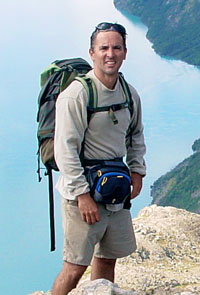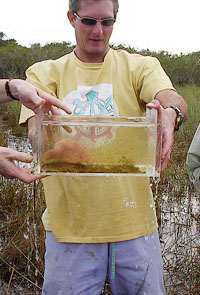February 28, 2011
Q&A with Dr. James Elser & Dr. Dan Childers

Dr. James Elser

Dr. Dan Childers
Voice-over: Phosphorus is essential. It is in our bones, our cells, even our DNA. Without it we would not survive. Phosphorus is limiting. We put it on our crops to produce the food we eat. Without it plants can’t grow. Phosphorus is polluting. When it washes off fields and lawns, it contaminates lakes and oceans. This can cause fish kills, algal blooms, and dead zones. Phosphorus is scarce. Only a few good sources of phosphorus are known worldwide, and demand rises every year. Without better management or new sources, we face a serious shortage.
What focused your interest on sustainable phosphorus?
James Elser: I’ve been working on phosphorus and its role in the environment and ecology and evolution for a long time. We know about phosphorus as a pollutant from how it makes lakes get green or over-green, but it wasn’t until I read a paper by Dana Cordell and Stuart White and some other researchers that the issue of phosphorus limitation of human society itself, because of it’s importance in agriculture, sort of came to me as a revelation of some kind.
Dan Childers: Before coming to ASU – I’ve been at ASU about two and a half years – I spent almost 15 years working in the Florida Everglades. The Florida Everglades is a massive wetland system that is very nutrient poor, what we call oligotrophic, and the limiting nutrient in the Everglades is phosphorus. So we deal with phosphorus concentrations in the Everglades on the order of 5-10 parts per billion – absolutely miniscule amounts of phosphorus. And one of the biggest problems with the Everglades is pollution from urban areas to the east of the Everglades where people live, and from agricultural areas to the north of the Everglades, and the pollution coming into the Everglades has excess phosphorus in it. So for a long time I thought, well, it’s amazing that there’s this natural system that is able to function on very, very low levels of phosphorus at the same time the human systems next door are so leaky and wasteful of it that extra phosphorus is coming into the Everglades from those human systems.
What is your most important sustainable phosphorus project?
James Elser: The biggest one right now that we’re involved in involves work on the role of phosphorus in ecology and evolution in some desert springs in Mexico, a place called Cuatro Cienegas, where phosphorus limitation is severe for all kinds of organisms. We think we can investigate and understand the ways that microorganisms deal with phosphorus limitation. We can start to discover genes and genetic strategies and biological strategies that living things have used to solve phosphorus scarcity issues. And hopefully those will be useful to us going forward as we approach phosphorus limitation ourselves.
Dan Childers: Since coming to ASU, I’ve become very involved in the Central Arizona–Phoenix Long-Term Ecological Research Project, and in particular my lab group is very involved in understanding and quantifying the effects of rain when it falls on a desert city. It effectively is a storm water project. So what we’re doing is we’re looking at the dynamics of how water moves through a desert city after it falls from the sky, and in particular, the transformations of various compounds in that water, as it moves through the city – phosphorus being one of those important compounds. A lot of the fresh-water systems in Phoenix, and we have a surprising number of them, are phosphorus-limited and so phosphorus supply from storm-water runoff is an important aspect of understanding the urban ecology of an arid-land city.
Q. How will your sustainable phosphorus research affect policy decisions?
James Elser: We’re trying to mobilize scientists and policymakers to get more serious about getting better information about where phosphorus is distributed and how it moves around in the system, so that we can begin to identify the places where there’s big inefficiencies in phosphorus use in our human system, so we can begin to tighten those up, so we can really achieve long-term sustainable agricultural systems.
Dan Childers: One of the big reasons for having the international Sustainable Phosphorus Summit is to directly inform policymakers, both in industry and in government. One of the advantages I think we face with the phosphorus challenge is that I see it as being a challenge where we have enough time before any real crisis hits that we can actually, potentially, begin to solve the problem before it becomes a critical crisis.
Q. What global sustainability challenge concerns you most?
James Elser: Ultimately the most important human activity that we have is to grow our food and to feed ourselves. And I think that achieving a truly sustainable agricultural system affects all aspects of human society – and it’s the one that needs the greatest amount of attention.
Dan Childers: The sustainability challenge that probably concerns me the most is what I teach my students in the School of Sustainability is the common denominator to all sustainability challenges, and that is human population growth. Our population has grown by 50 percent in the last 50 years. Thanks to the “green revolution” and to phosphorus fertilizers, we’re projected to grow by another 3 billion by 2050. Fundamentally that is the real challenge that we’re facing. The sustainable phosphorus issues fits into that greater human population challenge because people need food. And because phosphorus is a non-substitutable, irreplaceable element, it’s an absolute necessity for us producing the food that we need – without it we simply can’t eat.
February 28, 2011

